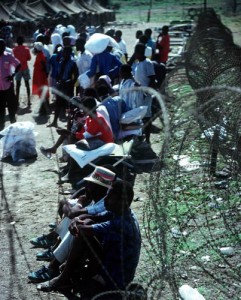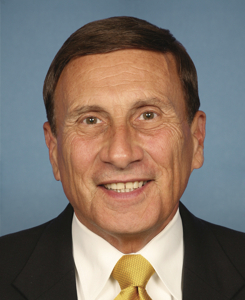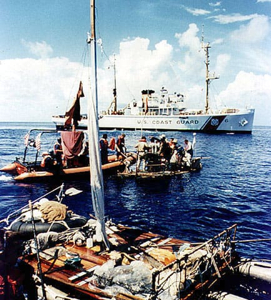 Introduction
Introduction
Whether the current displaced vulnerable civilians being sequestered at the US naval base on the southeastern shores of Cuba are being screened for infectious, debilitating diseases before being airlifted out to tent city has yet to be established, either by the government, or by the media.
This review, of an historical nature, traces the prevalence of the Haitian boat people population which was interdicted in the waters of the 600 mile stretch between the island and the Florida Coast, and the health status discovered inside the camp.
The regime at the White House under President Clinton, which had just won the election in 1992, although promises were made to treat the refugees from Haiti in a civilized manner with due process and asylum requests, reverted back to the former president’s method and little was done that changed the plight of those trapped in the Guantanamo Bay camps.
(Image: Guantánamo Public Memory Project – HIV-positive Haitians at Guantánamo Bay)
Methodology
The research will follow similar format of recent articles published on Borderlands surrounding the new White House policy. Capsules will contain a.) a social media post with a link (“X” post by @jameslangelle) where applicable, b.) an artificial intelligence query enclosed in parentheses (Begin Perplexity-AI) followed by (End Perplexity-AI), and c.) Notes, to analyze, clarify and refute, if necessary, the AI findings. The AI query will have a link to the search along with in-text links as to where the machine accessed the information.
New sections, Congressional Record and Newspaper Archives, have been added to give a more complete perspective of how the issue played out in the government and in public opinion.
Capsules
“X” Post by @jameslangelle
(no post available for this query)
(Begin Perplexity-AI)
guantanamo bay haitian refugees with aids brought to united states for treatment in 1993
In 1993, Haitian refugees with AIDS who were detained at Guantanamo Bay were brought to the United States for medical treatment. This occurred after a series of legal and humanitarian challenges to their detention:
- On March 26, 1993, U.S. District Judge Sterling Johnson Jr. ruled that the government had to either provide adequate medical treatment for the HIV-positive refugees at Guantanamo or send them where they could be treated8. He described the facility as an “HIV prison camp”5.
- Following this ruling, the Clinton Administration announced that 36 Haitian refugees with the AIDS virus would be brought to the United States2.
- On April 5, 1993, the first group of 20 Haitians, including 16 infected with HIV, were flown from Guantanamo to the United States2. Priority was given to those with low immune cell counts2.
- By June 1993, Judge Johnson ordered the release of all remaining HIV-positive Haitian refugees from Guantanamo within two weeks57.
- The camp housing these refugees, known as Camp Bulkeley, was finally closed on July 18, 19937.
This decision marked a significant shift in policy, as previously these refugees were denied entry to the U.S. solely based on their HIV status, despite being accepted as having legitimate claims for asylum14. The move came after concerns about inadequate medical care and poor living conditions at the Guantanamo facility145
https://www.perplexity.ai/search/guantanamo-bay-haitian-refugee-bZQ0541gQye6z.ICtFxIVw
(End Perplexity-AI)
Notes: Following the ruling by the judge, Congress took up the debate when the AIDS infected Haitians were brought into the United States for treatment, with those concerns entered into the Congressional Record.
Congressional Record
HIV -INFECTED REFUGEES
(Mr. SOLOMON asked and was given permission to address the House for 1 minute and to revise and extend his re- marks.)
Mr. SOLOMON. Mr. Speaker, recently a Federal judge ruled to admit the HIV -infected refugees being held in Guantanamo Bay into the United States.
Last week, the Washington Post reported that the White House will not appeal this ruling.

Mr. Speaker, has President Clinton already forgotten the NIH bill he signed that codified the ban against allowing people with deadly diseases into the United States? Doesn’t he realize the cost to taxpayers for each person admitted with the deadly HIV infection? And most importantly, doesn’t he realize that he is jeopardizing the health and well-being of American citizens?
I haven’t forgotten that it costs over $100,000 to care for each HIV infected individual. And, I haven’t forgotten that HIV always leads to AIDS, which always leads to death.
Mr. Speaker, this country needs the President to look out for her best interests, not his own political interests. It is time for the President to stop trying to be on all sides of an issue. He should instruct his Attorney General to appeal this case, and block these AIDS-infected immigrants from crossing our borders.
(Rep. Gerald B.H. Solomon, R-NY, 14 June 1993, 12567)
HIV-INFECTED HAITIAN ENTRY
The SPEAKER pro tempore. Under a previous order of the House, the gentleman from Florida [Mr. MICA] is recognized for 5 minutes.

Mr. MICA. Madam Speaker, I rise today to inform the Congress and the American people of an impending disaster. Last Thursday I was joined by more than 40 Members of Congress who asked our President to uphold the law of this land.
Current U.S. immigration law bans HIV-infected persons from entering this country. We asked the President to uphold this ban.
I want to make clear at the outset that I am the grandson of immigrants, and am proud of this country’s legal immigrants. But my grandparents were required to meet certain health requirements. That was the law then, and that is the law now.
However, something alarming has happened this morning and will continue to happen until U.S. law is enforced: This morning the United States Government flew dozens of HIV-infected Haitians, who were held at Guantanamo Bay, Cuba, to Florida. Eight more flights are scheduled to take the remaining refugees to the United States.
This action threatens Florida with a financial disaster. This action threat- ens a medical disaster for this country.
I am especially outraged because Congress has spoken on this issue. The House and other body both voted overwhelmingly to codify the rule specifying that HIV infection is a public health concern that is a basis for excluding anyone from any country from entry into the United States. What is even more compelling is that President Clinton recently signed the bill that contained this ban.
How did we get to where we are today, flying these HIV-infected Haitians to our country? A Federal judge is deciding U.S. policy on an issue that has far-reaching public health and fiscal consequences for our Nation. How can one judge so easily reverse the will of the Congress?
I dispute the notion that a Federal judge should make this kind of policy. There were over 40 other Members of this House that joined me in pleading with the President to prevent this catastrophe from occurring.
Our voices have not been heard. Apparently, the President is still debating whether or not to appeal this decision.
As I said, many of the HIV-infected Haitians are already here. The rest will follow. Once here, they will receive medical benefits and a host of other refugee program services.
I know that Florida cannot afford to bear the financial burden of these HIV-infected refugees. Florida has already taken a large number of the Haitian immigrants. Specifically, between 82 and 93 percent of the 10,000 plus Guantanamo Haitians brought to the United States have remained or returned to Florida. This imposes huge costs on our State. We have also just survived Hurricane Andrew and are attempting to rebuild those communities in south Florida. We simply cannot afford these high risk immigrants.
Madame Speaker, I urge my colleagues and fellow Americans to let President Clinton know that it is his chief responsibility to enforce the laws of our country.
He should appeal this decision immediately, and avert the potential financial and medical disaster for Florida and the Nation. (Rep. John L. Micah, R-FL, 14 June 1993, 12598)
Notes: The Republicans did not approve of the plan, including Micah, whose 7th district extended from Orlando to Jacksonville. By contrast, the Democrats had a different take on the ruling by the judge to allow HIV-infected Haitian refugees on to American soil for treatment.
At the same time, we have had some other developments which have moved things a bit. The Federal judge, Judge Sterling Johnson, ruled that the Haitians at Guantanamo Bay who have HIV infections must be brought to the United States and given appropriate medical care, a humane act which I consider very important if this Nation is to maintain its image in the world as really being a nation that cares about people. The White House did not challenge or appeal that ruling. That is another step forward. (Rep. Major Owens, D-NY, 14 June 1993, 12610, link above)
Newspaper Archives

Haitians With AIDS Coming To America
WASHINGTON (AP) — The Clin-ton administration will comply with a court order and allow 36 Haitian refugees with full-blown AIDS to come to the United States for treatment. But the Justice Department said Thursday that it is making an excep-tion to government policy, not lifting a ban on the 250 refugees detained for more than a year at the U.S. Naval Base in Guantanamo, Cuba, because either they or relatives accompanying them have the HIV virus that causes AIDS.
(The Vicksburg Post, 02 April 1993, A8)
Afterword
The White House and its tools of making America safe again, the DHS and ICE, have created quite a stir lately in its hard-nose tactics of rounding up enemies of the state, and, as the border czar flatly stated, “collateral” occupants of the premises where the undesirables were detained. The new homeland security secretary wasn’t so polite, calling them out as “dirtbags.” It is apparent there is a strategy to take out the criminals first and anyone who gets in the way of the arrests. The reaction has been mixed.
On social media, the usual suspects wave the sovereign flag, while out in the streets and on the freeways of the sanctuary cities, the sovereign flag is being stomped on and torched, while other flags are carried out into public and waved in the face of media.
Nowhere does there seem to be the overall health issues involved in detention, sequestering and flying the vulnerable civilians off to tent city. No statement out of the CDC, no public and private universities, health organizations, no mental health organizations. It may become a major problem at the base, and possibly a pandemic time bomb about to explode in the new immigration sweep strategy.












